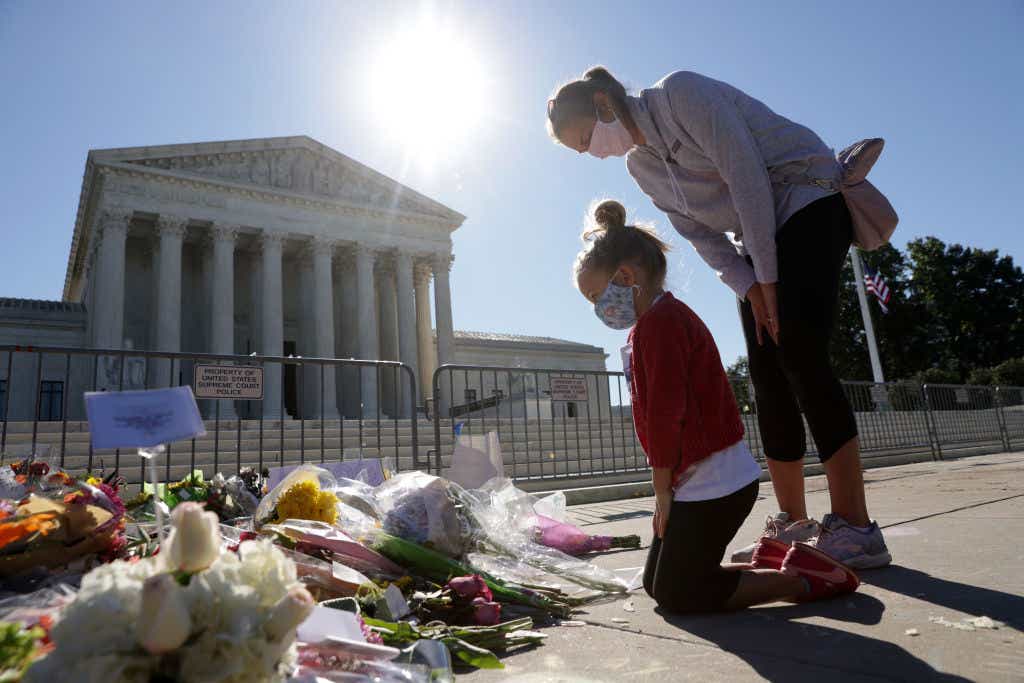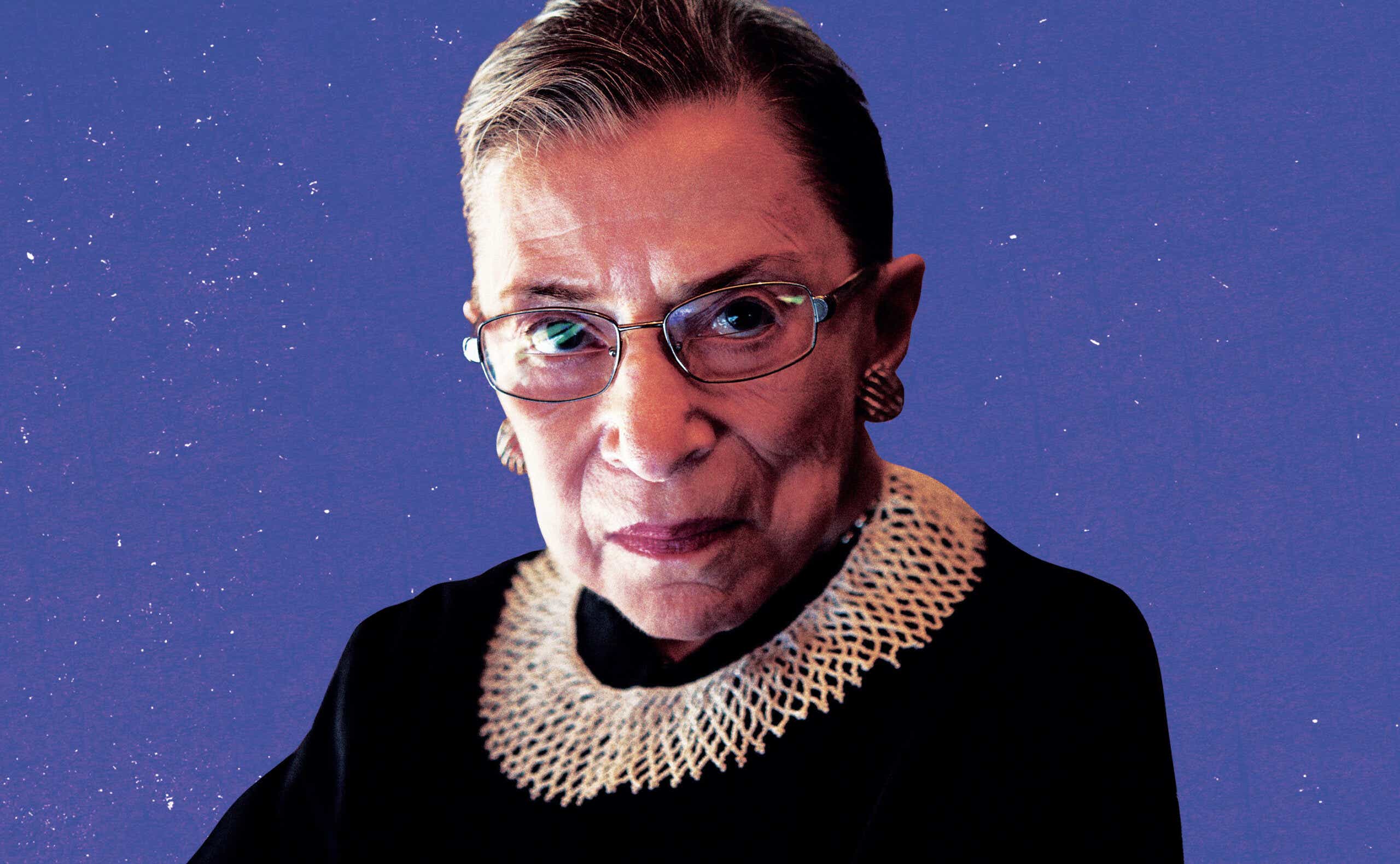The late Supreme Court Justice Ruth Bader Ginsburg — aka “the Notorious RBG” — very much remains both a feminist and pop culture icon. If you walk into any bookstore, there’s a good chance you’ll spot her image on paraphernalia ranging from mugs and bags to T-shirts and socks.
While her impact on women’s rights looms large, she did not. At 5-foot-1, the Brooklyn native was known to be both soft-spoken and shy. But those who knew her personally saw a different side. “She had a very quick wit and she was funny,” says Shannon Gilreath, a law professor at Wake Forest University, where Ginsburg was a frequent guest lecturer. “She was also a very feminine woman. I think people don't think that feminists and femininity can coexist, but they did in her.”
And yet even some of Ginsburg’s most ardent supporters have wrestled with her legacy and questioned whether she should have stepped down before her death at age 87 in September 2020, following a battle with pancreatic cancer. Because she didn’t, the timing of her passing allowed President Donald Trump to pick her successor, and some argue that her decision to remain on the court enabled the overturning of the landmark decision Roe v. Wade just two years later.
On the 30th anniversary of her joining the Supreme Court back in 1993, we’re observing the occasion with a look back at her historic appointment to the nation’s highest court — and the controversy over how long she stayed on it.
Who appointed Ruth Bader Ginsburg to the Supreme Court?
President Bill Clinton first appointed Ginsburg on June 14, 1993, making her the second woman (and first Jewish woman) ever to be nominated to the Supreme Court. She officially assumed the role two months later, on Aug. 10, when she was 60 years old.
Before her nomination, Ginsburg already had a formidable record on the D.C. Circuit Court of Appeals, where she was known as a “restrained and fair-minded judge who did her homework and then some,” according to a 1993 archive from Congressional Quarterly Almanac. So it was no surprise that she was easily confirmed by a Senate vote of 96-3 — quite a different scenario from Justice Clarence Thomas’ contentious confirmation hearings just two years prior.
She went on issue opinions on some of the most consequential rulings of our time, impacting sex discrimination, voting rights, religion, separation of church and state, and most notably, abortion. Later in her career, Ginsburg became known for her scathing dissents, like the one in the 2013 case Shelby County v. Holder, which gutted key parts of the Voting Rights Act of 1965 and allowed states to pass restrictive voting laws. These caught the eye of admirers, such as New York University law student Shana Knizhnik who created a Notorious RBG feed on Tumblr in her honor. The blog was sprinkled with pictures of the justice in a crown like the rapper Biggie Smalls, presented alongside quotes from Ginsburg’s court opinions.
“She was highly revered and admired within the legal world, but the public didn't know who she was,” says filmmaker Freida Lee Mock, who directed the 2019 film, Ruth: Justice Ginsburg in Her Own Words. “If it wasn’t for her dissent on Shelby v. Holder, she would never have become this pop icon.”

But some believe it was her time at the American Civil Liberties Union — before she ever joined SCOTUS — that reshaped the American legal system as we know it today. From 1972 to 1980, she served as the director of the nonprofit’s influential Women’s Rights Project and successfully argued six landmark cases before the U.S. Supreme Court. Ginsburg succeeded in establishing that the government couldn’t discriminate on the basis of sex, which included repeatedly defending male plaintiffs in cases that would also bring greater equality for women.
“Her core strategy during her ACLU years was the idea that dismantling patriarchy was necessary — not only for women's liberation, but for all of us,” says Ria Tabacco Mar, the Women’s Rights Project’s current director. “She showed the court that gender stereotypes actually hurt men too.”
What did Ruth Bader Ginsburg really think of Roe v. Wade?
Though she was a proponent of abortion access, Ginsburg wasn’t all that fond of Roe v. Wade — and that mainly had to do with the way the 1973 ruling was structured.
As she pointed out during a lecture at New York University in 1992, she thought the decision did too much too soon, and she felt the country should have taken a more incremental approach to legalizing abortion, rather than making every restriction of the procedure illegal in one fell swoop. “Doctrinal limbs too swiftly shaped, experience teaches, may prove unstable,” she said at the time.
To Ginsburg, Roe v. Wade was based on the wrong argument. The ruling hinged on the idea that restricting abortion access violated a woman’s privacy, but Ginsburg felt that it should have focused on gender equality as protected under the Equal Protection Clause of the Constitution. In her opinion, that would’ve made the decision less vulnerable to future attacks — and, as we would later see, that distinction turned out to be an important one.
"Roe isn't really about the woman's choice, is it?" Ginsburg told the University of Chicago Law School in May 2013. "It's about the doctor's freedom to practice...it wasn't woman-centered, it was physician-centered."

That said, legal experts say that ultimately, the reversal of Roe v. Wade was inevitable, regardless of the basis of the argument.
“I don't think the reversal of Roe v. Wade in the Dobbs opinion had anything to do with the quality of the legal arguments,” says Aziz Huq, a professor at the University of Chicago School of Law. “That's the product that changes in the composition of the court brought about through political mobilization and interest groups that have influenced or imposed a litmus test on the selection of judges that focuses on abortion.”
Those "changes in the composition of the court” are where things get particularly complicated for Ginsburg’s legacy.
Why didn’t Ruth Bader Ginsburg retire?
One common question that came up before — and especially after — Ginsburg’s death is whether she should have retired, which is more common on the Supreme Court than you might think. Even though U.S. Supreme Court justices have lifetime appointments, 39 out of 115 justices have chosen to step down, according to AARP.
Some believe Roe v. Wade — and the abortion rights that the ruling enshrined — could’ve been spared if Ginsburg had retired in 2013, with Obama in the White House and Democrats in control of the Senate. The thinking is the justice could've electively left the court during the Obama administration and she may have been replaced with a liberal-minded judge picked by our 44th president. Instead, the vacancy created by her death enabled then-President Trump to nominate her successor, Amy Coney Barrett, which created a major ideological shift. (Barrett, who’s a conservative, helped secure a 6-3 conservative majority on the court.)
While lawyer Linda Hirshman agrees that Ginsburg broke gender barriers and transformed women's rights, she also believes the justice should've left the court sooner given the legal implications. “Her most consequential decision from 1993 to 2020, when she died, was staying on beyond her sell-by date,” Hirshman tells Katie Couric Media.
Others point out that it's important to separate the personal from the professional in any critique. “I think it's very odd to criticize somebody for dying of cancer,” says Huq. “You can recognize the consequences of the timing of their death without thinking that it’s a matter of attributing fault.”

While it’s true that Ginsburg could have chosen to step down at any point, she made it clear that she had no plans to do so, even reportedly telling her granddaughter that she didn’t want to be replaced until a new president took office. “As long as I can do the job full-steam, I would like to stay here,” she said in 2018.
But even if Ginsburg had decided to leave, there was no guarantee whether Obama could’ve or would’ve nominated an "ultra-progressive" judge to the high court, or whether the Senate would have approved such a person.
"If I resign any time this year, he could not successfully appoint anyone I would like to see in the court,” Ginsburg told Elle magazine in a 2014 interview “[The Senate Democrats] took off the filibuster for lower federal court appointments, but it remains for this court. So, anybody who thinks that if I step down, Obama could appoint someone like me, they're misguided.”
Still, for many liberals, it’s easier to wrestle with the timing of Ginsburg’s retirement than it is to face the very real impact of the lack of abortion access affecting millions of Americans. And whether you think RBG is to blame for that or not, it’s clear that the court that made her world-famous is headed in quite a different direction than during her tenure.
“Ruth Bader Ginsburg put a great deal of faith in the legal process and our American institutions,” says Gilreath. “But I think there has now been a real push to tear them down.”









